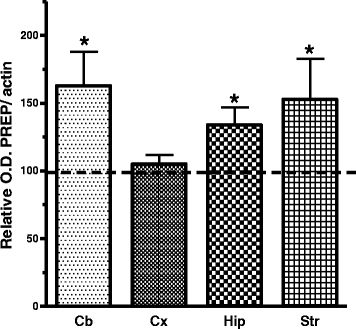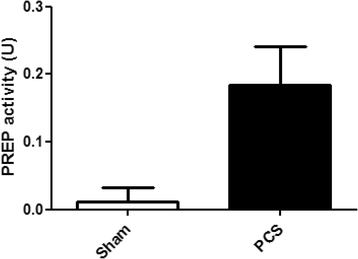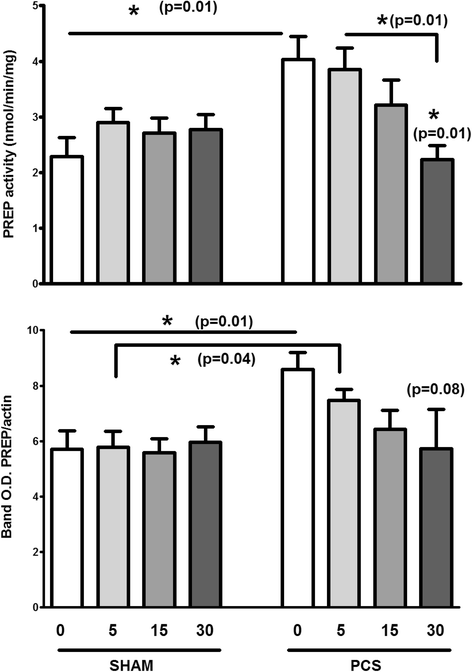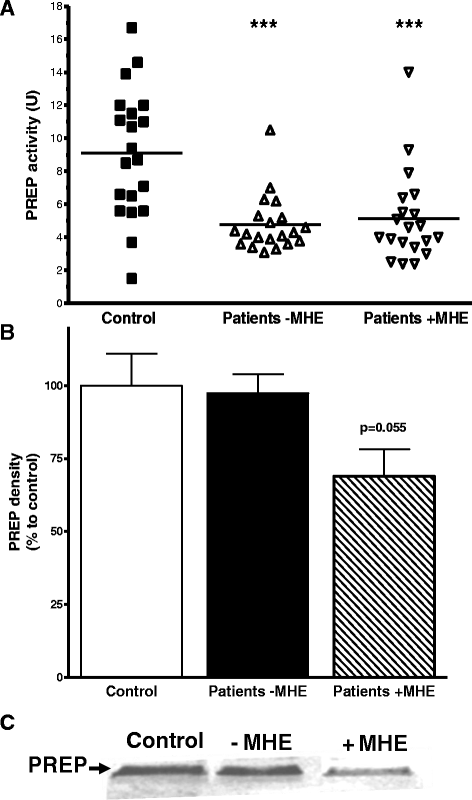The expression levels of prolyl oligopeptidase responds not only to neuroinflammation but also to systemic inflammation upon liver failure in rat models and cirrhotic patients
- PMID: 26420028
- PMCID: PMC4589196
- DOI: 10.1186/s12974-015-0404-7
The expression levels of prolyl oligopeptidase responds not only to neuroinflammation but also to systemic inflammation upon liver failure in rat models and cirrhotic patients
Abstract
Background: Liver failure in experimental animals or in human cirrhosis elicits neuroinflammation. Prolyl oligopeptidase (PREP) has been implicated in neuroinflammatory events in neurodegenerative diseases: PREP protein levels are increased in brain glial cells upon neuroinflammatory insults, but the circulating PREP activity levels are decreased in multiple sclerosis patients in a process probably mediated by bioactive peptides. In this work, we studied the variation of PREP levels upon liver failure and correlated it with several inflammatory markers to conclude on the relation of PREP with systemic and/or neuroinflammation.
Methods: PREP enzymatic activity and protein levels measured with immunological techniques were determined in the brain and plasma of rats with portacaval shunt (PCS) and after treatment with ibuprofen. Those results were compared with the levels of PREP measured in plasma from cirrhotic patients with or without minimal hepatic encephalopathy (MHE). Levels of several pro-inflammatory cytokines and those of NO/cGMP homeostasis metabolites were measured in PCS rats and cirrhotic patients to conclude on the role of PREP in inflammation.
Results: In PCA rats, we found that PREP levels are significantly increased in the hippocampus, striatum and cerebellum, that in the cerebellum the PREP increase was significantly found in the extracellular space and that the levels were restored to those measured in control rats after administration of an anti-inflammatory agent, ibuprofen. In cirrhotic patients, circulatory PREP activity was found to correlate to systemic and neuroinflammatory markers and had a negative correlation with the severity of the disease, although no clear relation to MHE.
Conclusions: These results support the idea that PREP levels could be used as indicators of cirrhosis severity in humans, and using other markers, it might contribute to assessing the level of neuroinflammation in those patients. This work reports, for the first time, that PREP is secreted to the extracellular space in the cerebellum most probably due to glial activation and supports the role of the peptidase in the inflammatory response.
Figures







References
-
- Ferenci P, Lockwood A, Mullen K, Tarter R, Weissenborn K, Blei AT. Hepatic encephalopathy--definition, nomenclature, diagnosis, and quantification: final report of the working party at the 11th World Congresses of Gastroenterology, Vienna, 1998. Hepatology. 2002;35(3):716–21. doi: 10.1053/jhep.2002.31250. - DOI - PubMed
Publication types
MeSH terms
Substances
LinkOut - more resources
Full Text Sources
Other Literature Sources
Miscellaneous

